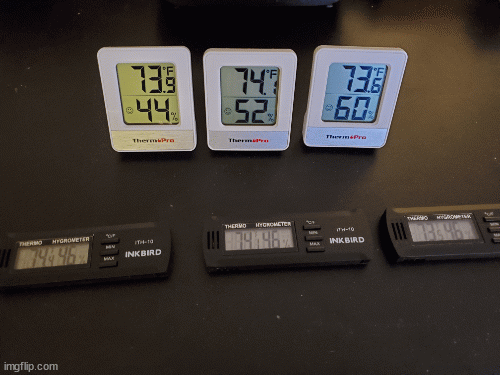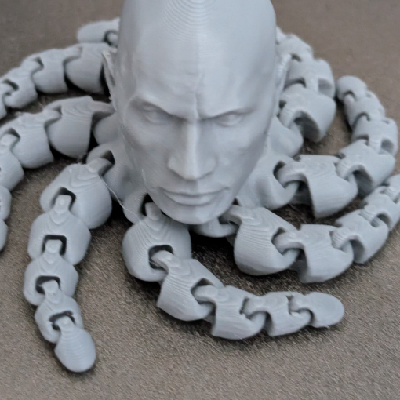These have to be the least accurate things I have ever seen.
The rectangular one is accurate or accurate enough and has been what I used but I noticed files all had cutouts for these round hygrometers…
Well from my 6 pack 1 is within a margin of error to even be useful.
I get they aren’t expensive but seems like a waste of money for this bad.
I would not be at all surprised to learn that both the commodity round and rectangular units use the exact same components inside. These surely must be made from jellybean off the shelf parts, and at similar price points to each other neither could possibly be assembled with much care or attention to detail.
I have a six pack of the rectangular ones from Jeff Bezos’ Knockoff Whitebox Emporium. Even all sealed in the same container with each other, they all disagree by a spread of about 15%. I have no idea which of the six, if any, are actually producing an accurate number.
So, just because my rectangular one has been with me for a few years I’m gonna stick up for it a little. It does have 2 sensors in it separated for temp and humidity compared to the circular ones that seem to have the temp sensor baked into the board if it exists at all and the humidity sensor was poorly soldered upside down. But agreed on likely carelessness of assembly from identical parts.
Same batteries and sensor modules it seems and even the press fit nature of them. And the only reason I know that specific one I’m reading against is accurate is because I only kept it because it was the accurate one from a pack of them I grabbed from a lab in college.
I just don’t get why everyone uses them is my point if we are in agreement they kinda suck.
because if it says anything other than 10% (the lowest thing it reads), then the dessicant needs to be refreshed.
it’s more of a binary output rather than trying to look at 53 vs 55%
You get your humidity down to less than 10%? Or still literally treating it like a binary thing and it’s just reading way under real?
I am at about 25% relative humidity and it’s showing as a 1 in the ams sensor so 10% seems impressive even though I’m not using much desiccant.
I’ve pretty much been running on the binary theory with the AMS sensor: anything but a 1 is too high. I guess I’m glad I didn’t waste any money on those digital jobbies. I wonder if the old school analog style are better?
Yeah, that seems good enough for most people and I agree with using it instead of wasting the money on these even for a secondary check. I just wanted to track a new desiccant that doesn’t indicate and see how it compares to cheap silica.
The old school probably would work better in that they are often adjustable or calibratable, and I feel like I’d trust them more than these to even accurately change with added humidity. I’m gonna end up using paper Testors cause those honestly seem the more reliable analog system.
The old horsehair types are pretty decent though not precision meters. The numbers will be completely off unless calibrated, but you can make multiple meters agree. Either way, you can see which days they take a massive dive.
Much the same as those bimetallic thermometers.
yeah, it’s usually 60% ambient humidity here, and then in the dry box it’ll read <15%. so that’s a pretty decent indicator to me that it’s working fine. I don’t really care if it’s 10, 15, or even your 25%, those are all way less than the ambient baseline and let me know that the dessicant is working.
If you’ve got some need to the humidity accuracy then that’s another thing, but for me that’s why I use those cheapos.
I use modified cereal containers with dessicant on the bottom and have a mount modelled up for those sensors.
Fair enough. I guess my point is that since they swing between them so much how do you know you didn’t put a sensor in there that is reading way under humidity and is actually closer to 40% while reading 15?
I guess it doesn’t really matter if it’s just to see if the humidity appears to be increasing over time but that difference between them makes me worry I won’t catch if it’s actually matching humidity because of a difference between the readouts.I’m also a very OCD nerd about certain things so, that’s not helping me with these. I feel I can’t compare any one of them against another for much purpose but only use them singularly at best for humidity change trend if I’m actively tracking it.
Say outside is reading higher than actual and inside is reading under actual and you might miss them being technically the same. I also just got non indicating desiccant so that’s another reason I kinda care.
I have an aqara temp/humidity sensor in my AMS. The hygrometer (rectangular type) shows 10% and aqara shows 19%.
I’ve also just been using the hygrometer as a binary if it is > 10% then I change media.
Typing all this up made me realize I need to just set an alert for the aqara to just tell me if it jumps above 20%.
@Krauerking@lemy.lol Hygrometers are only as good as their components. Buying a DHT11/22 or SHT31 from AliExpress ($1-2) alongside an ESP8266/32 and you’d have much better results than buying these “are my cigars dry” pucks.
I’d really love to know how, once having purchased and aquired these two parts, how to join them, and get them powered, and to display. this is like secret engineering knowledge i’d love to be walked through
@shoulderoforion@fedia.io I have about $150 worth of Ali parts and components coming just this month for whole house monitoring for this kinda thing - temp, humidity, CO2, VOCs, pressure, light sensors etc. Would be glad to ping y’all once that writeup is done :)
that’d be awesome abe, thanks
LOL same. And this is why I bought bad tech. It’s a whole wild world if you can actually take electronic components and just wire them together and program them yourself.
I’ve been through all the junk Amazon hygrometers, name brands, no name, all junk. How has your experience been with the inkbird ITH10? I hope abe writes up a walkthrough for the DHT11/22 and ESP8266/32 setup, it’d be neat to order from Ali and work something up.
Just bought them after the realization of this. I will try to make sure I let you know as I found a really good deal that I’d be happy to share as well if they are good as long as you are fine with used.
cheers mate
 After this thread the other day I bought some Inkbird’s on sale from Amazon to test them out, have had some ThermoPro TP39 around (and outside) of the house, and one of the Inkbirds was about 5% above on a salt test in a bag, out of the bag, they are all, seemingly reading LOW. Little sick of this, so I bought a Protmex HT607 to test out to see if my feeling is right, that the only one of the hygrometers in the photo that’s near correct (3%+/-) is the center ThermoPro. If my feeling is right, I’m going to return all the Inkbirds, and give ThermoPro some shit, make a warranty claim, where I’m sure they’ll send me 3 more junk hygormeters. I’m not prepared to spend $800 on a scientific hygrometer that can only do push button spot readings, can continue to be amazed that the market hasn’t produced an ADJUSTABLE always on moisture/humidity monitor. It’s pretty maddening.
After this thread the other day I bought some Inkbird’s on sale from Amazon to test them out, have had some ThermoPro TP39 around (and outside) of the house, and one of the Inkbirds was about 5% above on a salt test in a bag, out of the bag, they are all, seemingly reading LOW. Little sick of this, so I bought a Protmex HT607 to test out to see if my feeling is right, that the only one of the hygrometers in the photo that’s near correct (3%+/-) is the center ThermoPro. If my feeling is right, I’m going to return all the Inkbirds, and give ThermoPro some shit, make a warranty claim, where I’m sure they’ll send me 3 more junk hygormeters. I’m not prepared to spend $800 on a scientific hygrometer that can only do push button spot readings, can continue to be amazed that the market hasn’t produced an ADJUSTABLE always on moisture/humidity monitor. It’s pretty maddening.So I got my inkbird ITH10s and they are at least for me what I was looking for.
They aren’t all perfect and have a slight variation between them but they are consistent and only cost me $14 for 6 of them. And I’m really only trying to get a rough idea of difference between enclosure types.
But yeah these do feel consistently like e-waste that for most people’s need of tracking if their humidity on their filament has gone too high that the answer is just the color changing paper readers. That or old mechanical ones that are always on in a simpler way.
I’ve tried the old spring one’s too, and the spring quality determines the accuracy, but again, not over time. Turns out the Inkbirds are equally as accurate as the Protmex showed, all the TermoPro’s were junk, and after a brief chat with ThermoPro customer service they refunded my entire purchased which was over 6 months ago, so that was nice. I think my body has been conditioned by bad Hygrometers to misjudge waht 40% rh should feel like, but the inkbirds were a good find, am gonna keep the protmex to do spotchecks on the inkbirds every nowa and again
You might just end up spending all your time doing that, though.
Good times.
I don’t even think these would helpfully let you know if your cigars are dry. 2 of them barely changed humidity over time and I noticed the sensors were flush with the board instead of exposed.
I ended up buying inkbird ITH10s because I generally don’t go completely self made since I’m not overly tech crafty and more work with my hands crafty.
I’ve had massive differences in readouts in DHT22 from aliexpress. They are really not good sometimes
@callcc@lemmy.world SHT31/41 are better than DHT22 tbf. DHT would have a variance of about 2-5%. It also takes a while for it to stabilize.
Thanks for the tip. The BME280 are also not too bad.
@callcc@lemmy.world True - but it really depends what you’re measuring with BME280/680s though (680>280). As a combination temp/humidity/pressure they’re excellent, but for humidity alone I think SHT gives better “expected” readings than BME.
Someone nerded it out on arduino forums about five years ago: https://forum.arduino.cc/t/compare-different-i2c-temperature-and-humidity-sensors-sht2x-sht3x-sht85/599609/10
Is the one built into the AMS not good enough? I get that it only gives a level between 1 and 4 but it’s been fine for me with PLA and PETG 🤷♂️
I am doing some testing with a new desiccant and wanted to have some extra data for humidity. So it is honestly fine for function but not what I was going for.
Interesting. Well, when you get some numbers together, I’d be interested to see what you find out
“It’s on 3 now, I should do something.”
Does something
Waits two hours
AMS says 2
“Is it at 2.0 and dropping to 1 any moment now, or is it stabilized at 2.9? Or…”
I guess it’s not important, but I really would like to have some decimals. It’s not that I care about accuracy, but I would like to be able to see which direction it’s going.
Yeah I looked at a pack of these on amazon recently and had a good laugh at the tolerance they provided for one of the measurements.
@Krauerking you could look at calibrating the hygrometers or at least the offset.
https://www.stevejenkins.com/blog/2014/06/how-to-calibrate-a-hygrometer-humidity-sensor-using-the-salt-test/
Two point calibration with calcium chloride and sodium chloride might be even more accurateNah these do not have a calibration method.
Cheap and seemingly what the average consumer uses based on the 3d files all using them but not calibratable and wayyyyy off.
@Krauerking ah but you can measure the offset. A two point calibration should cover your measurement range. Not ideal but you could get a reading.
Yeah I did measure all their offsets actually already in a rougher method than the salt water trick. I’ve so far got
+27, +18, +14, +13, and +7 and 1 that is within +1 margin of error.
I dunno that just seems like a waste of electronics components. I can use them but… Yuck right?
@Krauerking yeah, yuck. The two point with Calcium chloride gives this insight. It has Relative humidity of around 33. If the offsets are constant then they may be worth using, with the ick factor of course. If the offsets don’t make sense then the detectors are shot and fit for the bin.
You can get calcium chloride at the hardware store, it’s used as Desiccant for damp areas.DampRid? Wait I already have calcium chloride then.
Ok well I guess I can test if they even scale right but I’m not holding my breath around them, I’m not sure the extra humidity I breath out anyways would register on these.
I really think I might just take the batteries from these and call it a loss and use better components.
Thank you for the testing info! Actually really helpful.
As an old toolmaker who might have dabbled in accuracy. I just shake my head when people complain about things like this because they think absolute accuracy --an impossibility-- is the important thing, (you can’t afford anything close absolute accuracy), when it’s repeatability that matters the most. Choose the one that repeats the best, toss the rest. Then learn what the “magic number” is that makes you happy to read and need to get the results you are looking for. Learn to apply some bloody “windage”.
Remember: Rick Sanchez is a dumb-ass. And you only need to be 5% smarter than the tool you are using to be successful. So be smarter than the tool and understand the process.
Do you have a recommendation for a more accurate unit?
Working on it. Waiting for some packages.
The rectangular ones are slightly more reliable from personal experience but likely just as possible to be low quality. From working with them the design layout leaves less space to get obvious flaws such as the RH sensor being installed facing the board which seems to be true for most of the round ones, they also have a separate and dedicated temp sensor unlike the round ones and use a double battery setup since voltage can also affect the accuracy of the reading.
But the RH sensor between the units seem to be identical as is the inability to calibrate.
Personally the paper strips are very reliable if just looking for a binary answer of if it’s gotten past a threshold and are incredibly cheap.
Abe recommended an electronic daughter board sensor that was cheap but requires skills I don’t have.
And I have found medical grade ones that can be purchased cheap “used” as they are often single use for shipping purposes to make sure the item was kept in specific conditions. But that brings me back to waiting for the. To arrive and test.
TL;DR
These cheap electric square or circle ones are both luck based with some preference to the square. But cheap paper humidity sensors can be gotten if you just want to toss them in a bag to make sure they haven’t gotten water damaged as a binary identifier.
For reliable accuracy look elsewhere.
I used 10 rectangular one for my dry boxes because they are cheap and its a rectangular one that was supplied with the Prusa enclosure.
It’s good to know that they seem to be more accurate than the round one.
Mine are pretty consistent, max. 5 percent points difference between them. Cheap brand from a big internet warehouse.
Lucky. Pretty sure these are the same from the same internet source but the swing on them is insane. They all showed as 75% in the bags but spending some time with them I realized the complete lack of accuracy when I realized my humidity wasn’t what it was reading.
I have since taken some apart and cleaned them out but now those are just under the humidity by the same percent they were over before.
The analogue one I own (round body) can be tuned/adjusted by a small screw on the back. Maybe that’s an option?
Not with these cheap electronic ones. Looks like there might have been a missing connector for resetting the RH value and a missing button to swap between F and C for temp.
Part of my calling these out as they seem very much useless.
Figures, I just bought two for the AMS lite.
Best of luck. Seems they are kinda luck of the draw.
They can I guess let you know trend of humidity go up or down but also do note that I noticed the sensor was installed upside down so readings also were pretty delayed from real world adjustments.
Mine work somewhat okayish, which is within the margin of error I need them for. I think there was one that was terrible though.
Mostly I use them for the temperature aspect, mostly for reminding me if it’s too hot or cold in my room (because due to my autism, I often don’t notice whether I’m at a comfortable temperature). I have a few scattered about my room and basically they act as a visual prompt to consciously ask myself if I’m at a comfortable temperature, and to act as a rough backup to whatever I’m feeling (because even when I’m consciously aware that my temperature is feeling Bad, I can’t reliably tell whether I’m too hot or cold, so these terrible thermometers at least help me answer “should I get a blanket, or open a window?”
How has your experience been with the inkbird ITH10?






